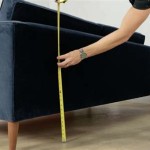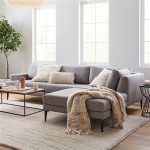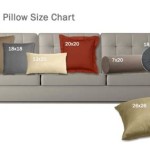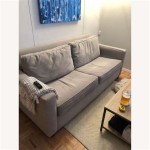Standard Sofa Dimensions
Understanding standard sofa dimensions is crucial for creating a functional and aesthetically pleasing living space. Choosing the right sofa size involves considering room dimensions, traffic flow, and desired seating capacity. This article provides a comprehensive overview of standard sofa dimensions, helping consumers make informed decisions when selecting the perfect sofa for their homes.
Sofa dimensions are typically expressed in terms of width, depth, and height. Width refers to the overall length of the sofa from one armrest to the other. Depth measures the distance from the front edge of the seat cushion to the back of the sofa. Height encompasses the vertical measurement from the floor to the highest point of the sofa, usually the top of the back cushions.
While variations exist among manufacturers and styles, some general guidelines apply to standard sofa dimensions. A typical three-seat sofa ranges from 72 to 96 inches in width. Two-seat sofas, also known as loveseats, generally measure between 50 and 70 inches wide. Apartment-sized sofas, designed for smaller spaces, typically range from 60 to 84 inches in width.
Sofa depth also varies. Standard sofa depth typically falls between 32 and 40 inches. Sofas with a deeper depth, often exceeding 40 inches, are generally considered oversized or deep-seated sofas, offering a more relaxed and lounging experience. Conversely, shallower depths, typically less than 32 inches, are common in apartment-sized sofas or spaces where maximizing floor space is a priority.
Sofa height typically ranges from 30 to 40 inches. This measurement includes the height of the back cushions and frame. Lower sofa heights can create a more contemporary and open feel, while higher backs offer greater head and neck support. The height of the seat, measured from the floor to the top of the seat cushion, is typically between 17 and 20 inches.
Beyond the basic sofa types, sectional sofas offer greater flexibility in configuration and sizing. Sectional sofas consist of multiple modules that can be arranged in various shapes and sizes to fit a specific space. The overall dimensions of a sectional sofa depend on the number and configuration of the chosen modules. Individual sectional components can range in size from small corner pieces to large chaise lounges.
When considering sofa dimensions, it's essential to account for the scale and proportions of the surrounding furniture and the room itself. A large sofa in a small room can overwhelm the space, while a small sofa in a large room can appear lost and disproportionate. Maintaining a balance between sofa size and room size is crucial for achieving a harmonious and functional layout.
Careful measurement of the intended space for the sofa is crucial before making a purchase. This involves measuring not only the length and width of the space but also the height of doorways and hallways to ensure the sofa can be easily maneuvered into the room. Creating a floor plan or using online room planning tools can help visualize the sofa's placement and ensure it fits comfortably within the designated area.
Beyond the overall dimensions, other factors influence sofa comfort and functionality. Cushion firmness, armrest height and style, and back cushion support all contribute to the overall seating experience. Considering these factors alongside the sofa's dimensions ensures a comfortable and suitable choice for individual needs and preferences.
Different sofa styles also influence the overall dimensions. For instance, a Chesterfield sofa with its rolled arms and tufted back will have different dimensions compared to a modern, minimalist sofa with sleek lines and low arms. Understanding the typical characteristics of different sofa styles can help narrow down the selection process and identify sofas that meet specific aesthetic and dimensional requirements.
The availability of detailed dimension specifications from manufacturers is a valuable resource. Consulting manufacturer websites or product brochures provides accurate measurements, ensuring the chosen sofa fits the intended space. Visiting furniture showrooms allows for in-person assessment of sofa dimensions and comfort, providing a tangible understanding of the sofa's scale and feel.
In addition to manufacturer specifications, consulting online furniture retailers often provides access to customer reviews and product dimensions. These resources can offer valuable insights into the actual size and comfort of a sofa, helping consumers make informed decisions based on real-world experiences.
Ultimately, selecting the right sofa involves a careful consideration of various factors, including room size, desired seating capacity, and personal preferences in style and comfort. Understanding standard sofa dimensions provides a crucial foundation for making an informed decision and creating a living space that is both functional and aesthetically pleasing.

Sofa Dimensions 101 Measuring For Your Perfect

Image Result For Standard Size Of Sofa In Mm Cool Couches Furniture Details Design

Sofa Dimensions For 2 3 4 And 5 Person Couches Charts Diagrams Design Formal Living Room Designs

Sofa Size Calculator

Standard Sofa Dimensions For 2 3 4 And 5 Person Charts Diagrams Engineering Discoveries

Standard Sofa Dimensions For 2 3 4 And 5 Person Charts Diagrams Engineering Discoveries

Farina Sofa Steel Grey Urban Ladder

Sofa Dimensions A Ultimate Guide With Drawings Homenish Layout Living Room Design Furniture Standard

Lifestyle Furniture Living And Dining Hall Nylon U Shape Sofa Set 3 2 Raja Digital Planet

Verona Sofa Ash Grey Velvet Urban Ladder








